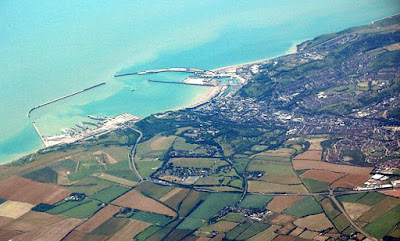 |
| Dover harbour, taken by Mtcv, Creative Commons 3.0 |
HMS Glatton was being built by Armstrong Whitworth for the Norwegians, when she was requisitioned by the British government. She was redeveloped as a monitor ship, a small, heavily armed, ship (two 9.2 inch guns, and four 6 inch guns) that could patrol shallow waters near to coastlines. It was 11 September 1918 when HMS Glatton finally left the north east for Dover where she would help troop ships between England and France.
The ship arrived in Dover on 12 September and was sat at the eastern entrance to the harbour while it waited to go into active service. Less than a week later, on 16 September, many of the 303 crew members were ashore for the evening, though over 100 were still on board. At 6:17pm, an explosion took place that sent flames three times the height of the mast into the air, followed by 600 foot plumes of white smoke.
Whilst the other ships in the harbour made ready to help, it was realised that a laden ammunition vessel, the Gransha, was only 150 feet from the Glatton. Fears that another explosion could occur, triggering a further explosion in the Gransha, prevented the ships from launching. A report from the Dover Express on 12 September 1924 reports that there was ‘a flag flying, the lowering of which would send the boats to the rescue of the survivors. Three minutes passed and no further explosion occurred. Then down went the flag and boats – steam, motor, and rowing – dashed off to the stricken vessel’. The Gransha began to move away from the burning boat.
There was now black smoke billowing from HMS Glatton as the oil fuel had caught fire. Men were being carried along the deck to the waiting boats which took them to shore, and to the hospital ship Liberty, also in the harbour. The first of the injured men were ashore before any ambulances arrived. Some were able to walk despite their burn injuries. At the same time, Vice Admiral Roger Keyes, who had been out of town, arrived by car and ran down the pier to take command of the situation. As well as the injured men, the bodies of one officer and 19 men were also recovered from the ship.
Of the injured men who were rescued, at least three were from County Durham. John Stoker, Norman Bell, and Robert William Rowe. Sadly, they died of their injuries in the following days.
John Stoker was born in Sunderland in 1898, his father served with the Durham Light Infantry during the war, recorded missing, presumed dead, on 26 May 1915. Two years later, John joined the Royal Navy. He died on 25 September 1918, and his body was returned to be buried in Mere Knolls Cemetery, Sunderland.
Norman Bell was born in Low Flatts, and moved to Birtley, then Washington. He worked as a coal miner until joining the navy in May 1918. Norman died on 27 September 1918, and his body was returned to be buried at St Mary’s Church, Horden.
Robert William Rowe was born in Sunderland, and was living in Murton Colliery by 1911. He joined the navy on the same date as Norman Bell in May 1918. He died the day after the explosion, 17 September, and his body was returned to be buried at Holy Trinity Churchyard, Murton.
The fire was still raging when everyone who could be found had been evacuated from the Glatton. There was still a fear of further explosions, leading to Vice Admiral Keyes making the decision to sink the ship to extinguish the fire. Garrison troops had to be called in to clear the seafront of spectators who made their way to a hill over looking the harbour. Around 8pm, three torpedoes were fired at vulnerable parts of the ship, and the HMS Glatton sank at 8:10pm with the remaining 57 crew still onboard.
 |
| Mr Pollard, and three of the divers who carried out the diving operation, Dover Express, 5 March 1926 (British Newspaper Archive) |
In early 1926, the HMS Glatton was raised from the bed of the harbour after several vessels had struck it. The work began in 1925 owing to the difficulty in raising the ship. 12000 tons of mud were removed from the decks and gunwhale. Other parts of the ship had to be cut, wires passed through, and an air tube inserted the length of the ship. When the weather and tide conditions were right, four lifting lighters were used. As they rose with the tide, so did the Glatton. It was moved, eventually coming to rest on the west side of the Submarine Harbour. The operation was thought to have cost £10000-12000.
 |
| Salving the Glatton, Illustrated London News, 6 March 1926 (British Newspaper Archive) |
It wasn't until 1930, when HMS Glatton was being broken up, that the bodies of the 57 crew were eventually recovered. They were buried at Gillingham (Woodlands) Cemetery on 4 April. The Commonwealth War Graves Commission shows that seven of these men were from County Durham: George Allanton of Sherburn Hill
Robert Knight of Burnopfield George Collingwood Robson of Low Fell
Thomas Scorer of Washington Station
Martin Small of Winlaton
John Wills of Murton Colliery
Matthew Waugh of Burnhope Colliery.
Durham at War stories
John Stoker
http://www.durhamatwar.org.uk/story/14489/
Robert William Rowe
http://www.durhamatwar.org.uk/story/14487/
Norman Bell
http://www.durhamatwar.org.uk/story/14488/
Matthew Waugh
http://www.durhamatwar.org.uk/story/12928/
Other sources:
Dover Express, 29 November 1918
Portsmouth Evening News, 5 March 1926
Leeds Mercury, 4 April 1930
https://doverhistorian.com/2015/03/07/glatton-the-catastrophe-and-the-salvage/
http://www.doverwarmemorialproject.org.uk/Information/Articles/Incidents/Glatton.htm

No comments:
Post a Comment